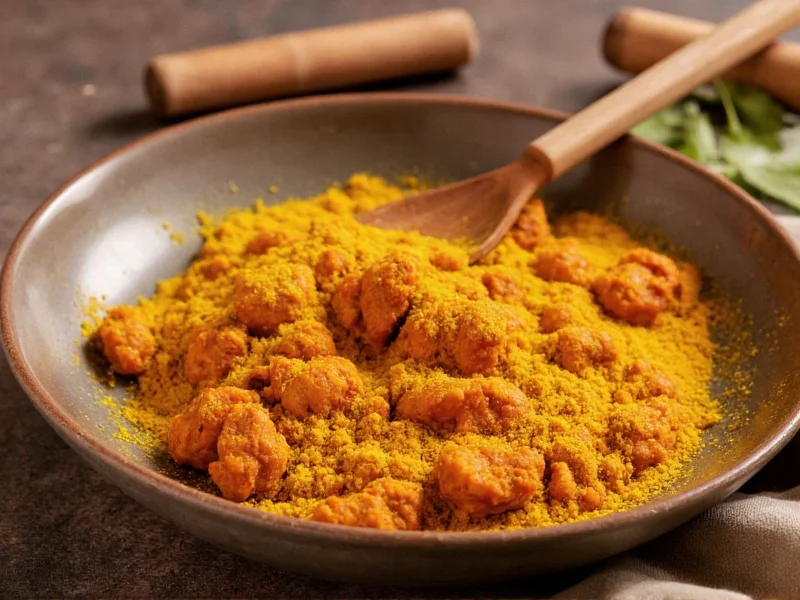Many home cooks confuse turmeric with curry, believing they're interchangeable terms. This misunderstanding stems from turmeric's prominent role in many curry dishes, particularly those from South Asian cuisines. The golden hue that defines many curry preparations comes primarily from turmeric, creating a visual association that often leads to confusion between the single spice and the complex dish or spice blend.
Understanding Turmeric: The Golden Spice
Turmeric (Curcuma longa) belongs to the ginger family and has been used for thousands of years in both culinary and traditional medicinal practices across Asia. The part used is the rhizome (underground stem), which when dried and ground produces the familiar bright yellow-orange powder.
Native to Southeast Asia and India, turmeric contains curcumin—its primary active compound responsible for both its vibrant color and potential health properties. Fresh turmeric root resembles ginger but boasts a more intense orange interior. When cooking with turmeric, remember that a little goes a long way due to its strong color and earthy, slightly bitter flavor profile.
Demystifying Curry: More Than Just a Spice
The term “curry” actually represents two distinct concepts:
- Curry as a dish category – Refers to numerous regional dishes from South Asia featuring vegetables, meat, or fish simmered in a sauce with spices
- Curry powder – A British colonial-era invention, a pre-mixed spice blend attempting to replicate various South Asian spice combinations
True Indian, Thai, or other regional cuisines don't typically use “curry powder”—instead, cooks create fresh spice blends for each dish. The concept of a standardized “curry powder” largely developed in 18th century Britain as an attempt to categorize diverse South Asian cooking styles.
| Characteristic | Turmeric | Curry Powder |
|---|---|---|
| Nature | Single spice (ground rhizome) | Spice blend (typically 5-15 ingredients) |
| Primary Color | Bright yellow-orange | Yellow to deep orange |
| Flavor Profile | Earthy, slightly bitter, peppery | Complex: warm, aromatic, variable heat |
| Key Components | Curcuminoids | Turmeric, coriander, cumin, fenugreek, chili |
The Relationship Between Turmeric and Curry
Turmeric serves as a foundational ingredient in many curry preparations, but represents just one component among numerous spices. In traditional Indian cooking, for example, a typical curry might include:
- Turmeric for color and earthiness
- Cumin for warmth
- Coriander for citrus notes
- Cardamom for floral complexity
- Mustard seeds for pungency
- Fenugreek for bitterness
- Chili for heat
When exploring authentic difference between turmeric and curry preparations, it's essential to recognize that turmeric alone cannot create a proper curry. The magic happens through the careful balancing of multiple spices, each contributing distinct flavor dimensions. Many commercial curry powders contain approximately 20-30% turmeric by weight, explaining why they share a similar color.
Using Turmeric Effectively in Curry Dishes
Understanding how to use turmeric in curry properly can transform your cooking. Consider these professional techniques:
- Bloom in oil – Heat turmeric in oil for 30-60 seconds before adding other ingredients to enhance flavor release and increase curcumin absorption
- Combine with black pepper – Piperine in black pepper can increase curcumin absorption by up to 2,000%
- Add early in cooking – Unlike delicate spices added at the end, turmeric benefits from longer cooking to mellow its bitterness
- Balance with acid – A splash of lemon juice or vinegar can counteract turmeric's natural bitterness
When substituting, remember that is turmeric the same as curry powder? Absolutely not. Using only turmeric where curry powder is called for will result in a one-dimensional flavor profile lacking the complexity of authentic curry dishes.
Health Considerations of Turmeric in Curry
Research into health benefits of turmeric in curry focuses primarily on curcumin, but important context is often missing from popular discussions. While laboratory studies show promise, real-world applications differ significantly:
- Curcumin represents only 2-8% of turmeric by weight
- Curcumin has poor bioavailability when consumed alone
- The traditional combination of turmeric with black pepper and fats in curry preparations significantly enhances absorption
- Most health studies use highly concentrated curcumin extracts, not culinary amounts
Enjoying turmeric as part of balanced curry dishes represents a traditional culinary approach that has stood the test of time, rather than chasing isolated health benefits. The why is turmeric used in curry question has both culinary and historical answers—its preservative qualities, vibrant color, and distinctive flavor all contributed to its prominence in South Asian cooking traditions.
Common Misconceptions Clarified
Several persistent myths surround turmeric and curry:
- Misconception: All curry contains turmeric
Reality: Many Thai curries (like green curry) use minimal or no turmeric, relying instead on other colorants like green chilies - Misconception: Curry powder is authentic to Indian cuisine
Reality: Most Indian households create fresh spice blends rather than using pre-mixed curry powder - Misconception: Turmeric and curry have identical health properties
Reality: Curry's health profile depends on the specific spices used in each preparation
Understanding these distinctions helps cooks appreciate the rich culinary traditions behind these ingredients rather than reducing them to oversimplified concepts. When exploring curry powder ingredients versus pure turmeric, remember that authentic cooking celebrates complexity over convenience.











 浙公网安备
33010002000092号
浙公网安备
33010002000092号 浙B2-20120091-4
浙B2-20120091-4